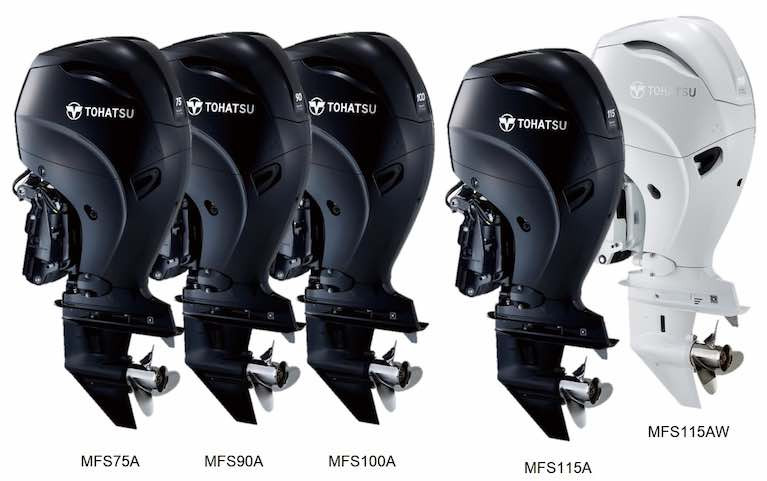Displaying items by tag: outboard engine
Suzuki Introduces a Trio of New Outboard Models for 2022
Suzuki is introducing three new outboard engine models to its range in the form of the DF140B, DF115B and the DF100C. These new outboards are mechanically controlled and replace the out-going DF140A, DF115A and DF100B models.
These new additions to the Suzuki outboard range provide an upgraded compression ratio of 10.6:1 for better top speed and quicker acceleration as well as increased fuel economy through improved thermal efficiency.
These new outboards also include a 40-amp alternator that delivers improved output and battery charging at low idle speeds. A redesigned cowling incorporates a new air intake structure with improved water separation and a silencer-resonator system to provide a more pleasant boating experience at all engine speeds. The new design also gives a smoother and more dynamic aesthetic appeal.
 Suzuki DF115B
Suzuki DF115B
To make routine maintenance easier, Suzuki has made it possible to replace the oil filter simply by removing the upper engine cover. To further increase ease of maintenance, the hole for the oil level gauge has been widened to 15mm which enables the use of a larger oil change hose. In addition, a new oil spill catcher on the filter mount prevents spillages and a new easy access water detection fuel filter helps protect the engine against contaminated fuel.
The DF140B, DF115B and DF100C provide heavy-duty performance and long-lasting durability in a lightweight, mechanically controlled package and are also the first four-stroke outboards to utilise an oil cooler, ensuring that all that horsepower is available in any conditions.
 Suzuki DF100C
Suzuki DF100C
Mark Beeley, Head of Marine & ATV for Suzuki GB said, “The new DF140B, DF115B and DF100C models are the latest in a long line of our innovative, lightweight and fuel-efficient four-stroke outboards that give customers the power, performance and reassurance that they need for a wide variety of boating activities.”
The Suzuki outboard engine range is available in Ireland from selected handlers including Viking Marine and OS Marine
Cox Powertrain, a leading British manufacturer of high-powered diesel outboard engines for the global marine industry, is pleased to announce it has successfully raised £9 million from existing shareholders and a further £3 million loan from HSBC UK Equipment Finance to allow the company to expand and ramp up production of the market-revolutionising CXO300 outboard engine.
Since 2007, Cox Powertrain has been continuously backed by private investors who share the determination and passion for Cox’s success. Production of the CXO300 successfully began in May 2020 and since then, the CXO300 has been shipped to over 16 territories across the globe.
The CXO300 is built at Cox Powertrain’s HQ in Shoreham, UK, where £6.7 million from preceding investment was used to finance a highly advanced and state-of-the-art production facility. This facility was carefully planned and was built with flexibility and scalability in mind to ensure it could be adapted to keep up with demand.
When the CXO300 was launched, orders were already on the books and since production began in May 2020, there has been a significant increase in demand, with Cox having a strong order book to reflect this. 2021 is set to be a strong year for Cox and this huge investment of £12 million is a testament to the market’s confidence in the product.
Tim Routsis, CEO of Cox Powertrain, said, “2020 was a year of milestones for Cox Powertrain as we entered production of the CXO300 despite the challenges of the global effects of Covid-19. This injection of capital allows us to now scale up our business and fulfill our growing order books.”
“I would like to thank our worldwide suppliers and acknowledge their hard work under extreme Covid-related constraints. This has been incredibly challenging for everyone, so we hope Cox’s continued support will allow them to increase their production to enable us to meet the market demands.”
Cox Powertrain has already begun to put plans in place to acquire more parts to ensure a successful transition into ramp-up and they are eager to begin.
O'Sullivan's Marine Launch Tohatsu's New Mid Range Outboard Motors
O'Sullivan's Marine aims to deliver the ultimate boating experience by providing outboard motors that are simple, easy to use and of outstanding quality. Tohatsu, one of our most popular brands, and one of the oldest manufacturers of outboard motors in Japan have just launched a new range of engines that we are particularly excited about!
The All New Tohatsu 4 Stroke Mfs75/90/100/115hp
With this new range of engines, Tohatsu has certainly delivered responsive acceleration, fast top-end speed and simple engine operation that offers you a fun and memorable boating experience!
 The new Tohatsu outboard engine range has been launched in Ireland
The new Tohatsu outboard engine range has been launched in Ireland
Revolutionary Design
Horsepower is determined by displacement and maximum RPM, but increasing displacement makes the weight increase, which is not a favourable option. Minimising displacement, yet at the same time maximising the performance of acceleration was the biggest challenge in designing these new engines. To address this Tohatsu have re-imagined the conventional stereotype exhaust system to create a '4-2-1 Performance Tuned Exhaust' giving maximum torque and acceleration performance.
 Tohatsu Performance Tuned Exhaust
Tohatsu Performance Tuned Exhaust
Easier Maintenance
Maintenance features are key to engine longevity. Tohatsu have added new features for easier maintenance:
- An oil catch tray for cleaner oil filter changes.
- An auto-tensioner for stress-free timing belt adjustment.
- Roller locker arms for minimal friction for reduced wear.
Summary of New Tohatsu Characteristics
- Unique 4-2-1 Performance Tuned Exhaust manifold has been designed to maximize
low-end torque and acceleration performance. - Best in class torque – displacement ratio creates excellent performance for all styles
of boats from lightweight to heavyweight. - Key elements of Simpliq ™ Technology; Simple Architecture, Easy to Use Interface
and Absolute Quality are all in these models
Tohatsu has also added the very stylish 'BELUGA WHITE' model for their existing MFS50 and 60HP long shaft engines, as well as the new MFS115HP Long and Ultra Long shaft.
Contact O'Sullivan's Marine below for more information on pricing and availability for the Tohatsu engine range, as well as Suzuki, Yamaha and Honda outboards.
SB20 Class Ditches Outboard Engine In Favour of Paddles, Crew Weight Limit Also Goes Overboard
#sb20 – The Irish SB20 fleet has voted to remove the obligation to carry an outboard engine and fuel on the six–metre sportsboat class during racing. The class has also ditched the crew weight limit.
According to class president Justin Burke, the removal of the engine rule (rule C.5.1(6)) in favour of a new rule to carry two paddles instead has been a debatable point among class members. 'Some see an engine as a fall back safety option and others see it as a danger' he told Afloat.ie
The rule will save weight of up to 21 kg and its abolition follows a similar path taken by the intenational class where the 'outboard engine rule' was amended four years ago at the SB20 Worlds Championships.
In other changes, there will be no restriction on crew weight, there will be no weigh in and no requirement to be 270kg or less to race except for the SB20 national championship.
A 2015 calendar will issue shortly.
Northern Ireland Police Launch Plan to Tackle Boat Crime
The Police Service of Northern Ireland has launched a new initiative to tackle boat crime.
Police officers will be visiting boat clubs in the next few months to discuss crime prevention measures that members can take. In addition, officers will be supplying clubs with a limited number of specially designed engine covers to make outboard boat engines less desirable to thieves.
Crime Prevention Inspector David Connery explains: "Last year, 24 boats were stolen in Northern Ireland and 58 outboard engine thefts were reported. Due to the nature of these crimes, it can take quite a while for the theft to be reported to us and detecting the equipment may prove difficult."
Inspector Connery said that Police want to work alongside responsible owners to reduce thefts from boats in their area and help deter potential offenders.
He continued: "Thieves are attracted to outboard engines as they are relatively easy to detach from the boat. We're encouraging owners to remove the original cowling and replace with a cover; the resale value for the engine plummets when this isn't present.
"Other crime prevention steps that boat owners can take include:
RECORD IT - Make a complete inventory of your equipment, especially outboard motors. Include serial numbers and any identifying marks specific to your property. Photograph items that are distinctive and keep with your inventory.
MARK IT - Mark property with your postcode and name/house number in a concealed area. There are many ways to do this from etching or marking with waterproof indelible pen to 'Smartwater' (or other specialist identifying methods).
REMOVE IT - The best way to keep thieves from stealing property is not to leave valuables onboard – removing electronic equipment and other valuables will eliminate the majority of thefts. Although many boats have lockable storage installed by boat manufacturers, they are sometimes not adequate to deter thieves. Off the shelf locks and security hinges can assist with security. Window locks on sliding windows (or placing a strip of wood where the glass slides) will assist with security.
CLUB SECURITY - A tactful offer to assist a stranger on the premises in finding a person or boat will help to deter a thief and assist a genuine member.
LOCK IT - Lightweight hasps and locks are easily broken or cut providing access to equipment stored in lockers. Outboard motor locks and quality shielded 'heavy duty' locks can assist; although they are more expensive initially, a quality lock will prevent a thief from taking your property. Inflatable tenders are easily moved and are a popular item for resale; secure them to a fixed point using a quality chain or lock.
REPORT IT - Report any thefts immediately to Police, your club and your insurance company. Use your inventory and photographs to assist in giving as much information as possible.
For further information on marine security please contact your local Crime Prevention Officer on 0845 600 8000.


























































